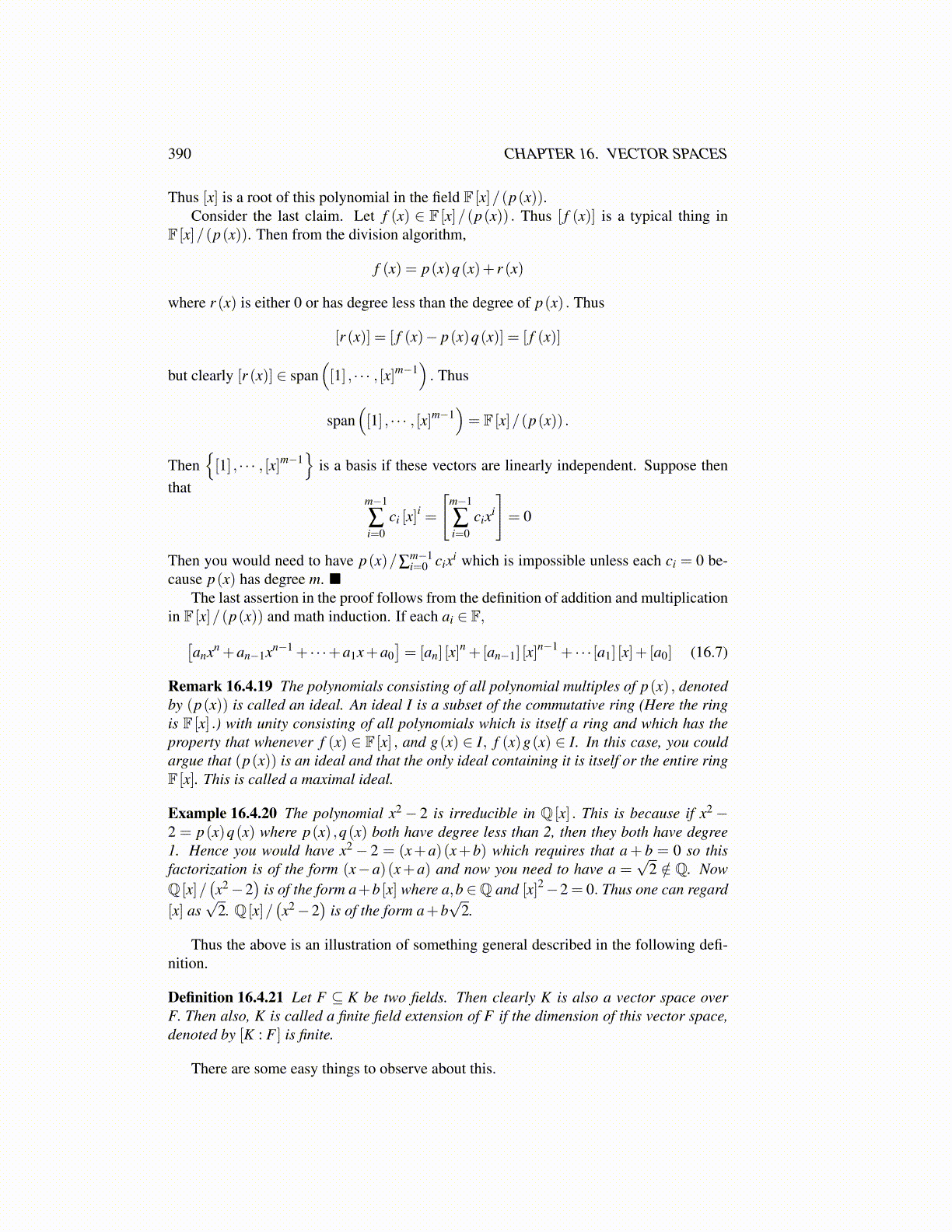
390 CHAPTER 16. VECTOR SPACES
Thus [x] is a root of this polynomial in the field F [x]/(p(x)).Consider the last claim. Let f (x) ∈ F [x]/(p(x)) . Thus [ f (x)] is a typical thing in
F [x]/(p(x)). Then from the division algorithm,
f (x) = p(x)q(x)+ r (x)
where r (x) is either 0 or has degree less than the degree of p(x) . Thus
[r (x)] = [ f (x)− p(x)q(x)] = [ f (x)]
but clearly [r (x)] ∈ span([1] , · · · , [x]m−1
). Thus
span([1] , · · · , [x]m−1
)= F [x]/(p(x)) .
Then{[1] , · · · , [x]m−1
}is a basis if these vectors are linearly independent. Suppose then
thatm−1
∑i=0
ci [x]i =
[m−1
∑i=0
cixi
]= 0
Then you would need to have p(x)/∑m−1i=0 cixi which is impossible unless each ci = 0 be-
cause p(x) has degree m. ■The last assertion in the proof follows from the definition of addition and multiplication
in F [x]/(p(x)) and math induction. If each ai ∈ F,[anxn +an−1xn−1 + · · ·+a1x+a0
]= [an] [x]
n +[an−1] [x]n−1 + · · · [a1] [x]+ [a0] (16.7)
Remark 16.4.19 The polynomials consisting of all polynomial multiples of p(x) , denotedby (p(x)) is called an ideal. An ideal I is a subset of the commutative ring (Here the ringis F [x] .) with unity consisting of all polynomials which is itself a ring and which has theproperty that whenever f (x) ∈ F [x] , and g(x) ∈ I, f (x)g(x) ∈ I. In this case, you couldargue that (p(x)) is an ideal and that the only ideal containing it is itself or the entire ringF [x]. This is called a maximal ideal.
Example 16.4.20 The polynomial x2− 2 is irreducible in Q [x] . This is because if x2−2 = p(x)q(x) where p(x) ,q(x) both have degree less than 2, then they both have degree1. Hence you would have x2− 2 = (x+a)(x+b) which requires that a+ b = 0 so thisfactorization is of the form (x−a)(x+a) and now you need to have a =
√2 /∈ Q. Now
Q [x]/(x2−2
)is of the form a+b [x] where a,b ∈Q and [x]2−2 = 0. Thus one can regard
[x] as√
2. Q [x]/(x2−2
)is of the form a+b
√2.
Thus the above is an illustration of something general described in the following defi-nition.
Definition 16.4.21 Let F ⊆ K be two fields. Then clearly K is also a vector space overF. Then also, K is called a finite field extension of F if the dimension of this vector space,denoted by [K : F ] is finite.
There are some easy things to observe about this.